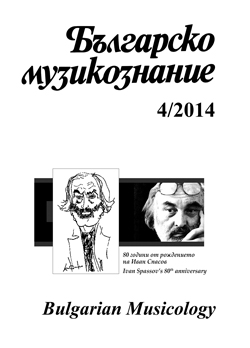Влиянието на късноромантичните традиции в един ранен български цикъл - „Лирични пиеси" за пиано оп. 6 от Андрей Стоянов
Influence of late Romantic traditions on an early Bulgarian cycle, Lyrical Pieces for Piano Op. 6 by Andrey Stoyanov
Author(s): Rostislav YovchevSubject(s): Music
Published by: Институт за изследване на изкуствата, Българска академия на науките
Keywords: Andrey Stoyanov; Bulgarian music; Lyric Pieces for Piano Op. 6; keyboard works; interpretation.
Summary/Abstract: The article offers the first ever analysis of a cycle, Lyrical Pieces for Piano Op. 6 by Academician Andrey Stoyanov (1890–1969), the pioneer of Bulgarian piano school. He composed also the cycles Aquarelles, Following Sunny Roads (Parts 1 and 2), Album for the Young, Sonatina and teaching-oriented pieces. His student, Prof. Charakchieva recalled that in his lifetime many of the above mentioned early and very valuable pieces had been performed frequently. Following his death, however, his works gradually ‘vanished’ from music venues for political reasons. The study raises essential issues related both to the Romantic pro- file of the pieces in Op. 6 and to all the keyboard works of Andrey Stoyanov’s legacy, revealing a complex person, an intellectual and a polymath, a composer, a pianist, a teacher, a philosopher, an essayist and a musicologist. This analytical reading is offered in an attempt to draw the attention of performing musicians and researchers, revealing Andrey Stoyanov’s fine compositional artistry of a composer skilled in rendering pro- found musical meaning to the subtlest details, and in developing musical thoughts abounding in ideas in a minor genre. Apart from an in-depth, harmonic and dramaturgic analyses of each of the pieces, the study seeks to explicate the tonal closeness of the first prelude to the third piece of Seven Piano Pieces, Op. 11 by Zoltán Kodály, composed almost at the same time; a parallel between the intimate lyricism of the second prelude and a number of chamber pieces by Sergei Rachmaninoff or Joseph Marx; some similar compositional devices, which in the third piece, Tale are reminiscent of Richard Wagner, etc. It is not just a formal resemblance, far from that, but rather inherently encoded internal bonds placing the early works of the great Bulgarian composer in a natural relation to the developments in Europe’s music life what it used to be just prior to and during his early creative activity. It explains to a great extent why Andrey Stoyanov’s works did not fit in the consequent line of development of Bulgarian compositional thought and regardless of their brilliance evaded the attention of per- formers and music researchers.
Journal: Българско музикознание
- Issue Year: 2014
- Issue No: 4
- Page Range: 38-54
- Page Count: 17
- Content File-PDF

